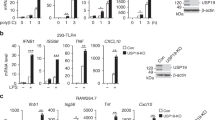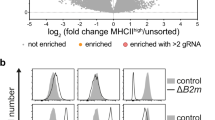Abstract
The Ubc13 E2 ubiquitin-conjugating enzyme is key in the process of 'tagging' target proteins with lysine 63–linked polyubiquitin chains, which are essential for the transmission of immune receptor signals culminating in activation of the transcription factor NF-κB. Here we demonstrate that conditional ablation of Ubc13 resulted in defective B cell development and in impaired B cell and macrophage activation. In response to all tested stimuli except tumor necrosis factor, Ubc13-deficient cells showed almost normal NF-κB activation but considerably impaired activation of mitogen-activated protein kinase. Ubc13-induced activation of mitogen-activated protein kinase required, at least in part, ubiquitination of the adaptor protein IKKγ. These results show that Ubc13 is key in the mammalian immune response.
This is a preview of subscription content, access via your institution
Access options
Subscribe to this journal
Receive 12 print issues and online access
$209.00 per year
only $17.42 per issue
Buy this article
- Purchase on Springer Link
- Instant access to full article PDF
Prices may be subject to local taxes which are calculated during checkout






Similar content being viewed by others
References
Ghosh, S. & Karin, M. Missing pieces in the NF-κB puzzle. Cell 109, S81–S96 (2002).
Weil, R. & Israel, A. T-cell-receptor- and B-cell-receptor-mediated activation of NF-κB in lymphocytes. Curr. Opin. Immunol. 16, 374–381 (2004).
Chang, L. & Karin, M. Mammalian MAP kinase signalling cascades. Nature 410, 37–40 (2001).
Akira, S. & Takeda, K. Toll-like receptor signalling. Nat. Rev. Immunol. 4, 499–511 (2004).
Kobayashi, T., Walsh, M.C. & Choi, Y. The role of TRAF6 in signal transduction and the immune response. Microbes Infect. 6, 1333–1338 (2004).
Chung, J.Y., Park, Y.C., Ye, H. & Wu, H. All TRAFs are not created equal: common and distinct molecular mechanisms of TRAF-mediated signal transduction. J. Cell Sci. 115, 679–688 (2002).
Lin, X. & Wang, D. The roles of CARMA1, Bcl10, and MALT1 in antigen receptor signaling. Semin. Immunol. 16, 429–435 (2004).
Ruland, J. et al. Bcl10 is a positive regulator of antigen receptor-induced activation of NF-κB and neural tube closure. Cell 104, 33–42 (2001).
Ruland, J., Duncan, G.S., Wakeham, A. & Mak, T.W. Differential requirement for Malt1 in T and B cell antigen receptor signaling. Immunity 19, 749–758 (2003).
Jun, J.E. et al. Identifying the MAGUK protein Carma-1 as a central regulator of humoral immune responses and atopy by genome-wide mouse mutagenesis. Immunity 18, 751–762 (2003).
Hara, H. et al. The MAGUK family protein CARD11 is essential for lymphocyte activation. Immunity 18, 763–775 (2003).
Egawa, T. et al. Requirement for CARMA1 in antigen receptor-induced NF-κB activation and lymphocyte proliferation. Curr. Biol. 13, 1252–1258 (2003).
Ruefli-Brasse, A.A., French, D.M. & Dixit, V.M. Regulation of NF-κB-dependent lymphocyte activation and development by paracaspase. Science 302, 1581–1584 (2003).
Newton, K. & Dixit, V.M. Mice lacking the CARD of CARMA1 exhibit defective B lymphocyte development and impaired proliferation of their B and T lymphocytes. Curr. Biol. 13, 1247–1251 (2003).
Sun, L., Deng, L., Ea, C.K., Xia, Z.P. & Chen, Z.J. The TRAF6 ubiquitin ligase and TAK1 kinase mediate IKK activation by BCL10 and MALT1 in T lymphocytes. Mol. Cell 14, 289–301 (2004).
Deng, L. et al. Activation of the IκB kinase complex by TRAF6 requires a dimeric ubiquitin-conjugating enzyme complex and a unique polyubiquitin chain. Cell 103, 351–361 (2000).
Wang, C. et al. TAK1 is a ubiquitin-dependent kinase of MKK and IKK. Nature 412, 346–351 (2001).
Shim, J.H. et al. TAK1, but not TAB1 or TAB2, plays an essential role in multiple signaling pathways in vivo. Genes Dev. 19, 2668–2681 (2005).
Sato, S. et al. Essential function for the kinase TAK1 in innate and adaptive immune responses. Nat. Immunol. 6, 1087–1095 (2005).
Spence, J., Sadis, S., Haas, A.L. & Finley, D. A ubiquitin mutant with specific defects in DNA repair and multiubiquitination. Mol. Cell. Biol. 15, 1265–1273 (1995).
Pickart, C.M. & Fushman, D. Polyubiquitin chains: polymeric protein signals. Curr. Opin. Chem. Biol. 8, 610–616 (2004).
Hofmann, R.M. & Pickart, C.M. Noncanonical MMS2-encoded ubiquitin-conjugating enzyme functions in assembly of novel polyubiquitin chains for DNA repair. Cell 96, 645–653 (1999).
Muralidhar, M.G. & Thomas, J.B. The Drosophila bendless gene encodes a neural protein related to ubiquitin-conjugating enzymes. Neuron 11, 253–266 (1993).
Zhou, H. et al. Bcl10 activates the NF-κB pathway through ubiquitination of NEMO. Nature 427, 167–171 (2004).
Zhou, R. et al. The role of ubiquitination in Drosophila innate immunity. J. Biol. Chem. 280, 34048–34055 (2005).
Andersen, P.L. et al. Distinct regulation of Ubc13 functions by the two ubiquitin-conjugating enzyme variants Mms2 and Uev1A. J. Cell Biol. 170, 745–755 (2005).
Zhou, H., Du, M.Q. & Dixit, V.M. Constitutive NF-κB activation by the t(11;18)(q21;q21) product in MALT lymphoma is linked to deregulated ubiquitin ligase activity. Cancer Cell 7, 425–431 (2005).
Habelhah, H. et al. Ubiquitination and translocation of TRAF2 is required for activation of JNK but not of p38 or NF-κB. EMBO J. 23, 322–332 (2004).
Kobayashi, N. et al. Segregation of TRAF6-mediated signaling pathways clarifies its role in osteoclastogenesis. EMBO J. 20, 1271–1280 (2001).
Gohda, J., Matsumura, T. & Inoue, J. Cutting edge: TNFR-associated factor (TRAF) 6 is essential for MyD88-dependent pathway but not toll/IL-1 receptor domain-containing adaptor-inducing IFN-β (TRIF)-dependent pathway in TLR signaling. J. Immunol. 173, 2913–2917 (2004).
Xue, L. et al. Defective development and function of Bcl10-deficient follicular, marginal zone and B1 B cells. Nat. Immunol. 4, 857–865 (2003).
Hayden, M.S. & Ghosh, S. Signaling to NF-κB. Genes Dev. 18, 2195–2224 (2004).
Chen, Z.J. Ubiquitin signalling in the NF-κB pathway. Nat. Cell Biol. 7, 758–765 (2005).
Carter, A.B., Monick, M.M. & Hunninghake, G.W. Both Erk and p38 kinases are necessary for cytokine gene transcription. Am. J. Respir. Cell Mol. Biol. 20, 751–758 (1999).
Scherle, P.A. et al. Inhibition of MAP kinase kinase prevents cytokine and prostaglandin E2 production in lipopolysaccharide-stimulated monocytes. J. Immunol. 161, 5681–5686 (1998).
Zhang, Y. et al. Regulation of innate and adaptive immune responses by MAP kinase phosphatase 5. Nature 430, 793–797 (2004).
Shinohara, H. et al. PKC beta regulates BCR-mediated IKK activation by facilitating the interaction between TAK1 and CARMA1. J. Exp. Med. 202, 1423–1431 (2005).
Shi, C.S. & Kehrl, J.H. Tumor necrosis factor (TNF)-induced germinal center kinase-related (GCKR) and stress-activated protein kinase (SAPK) activation depends upon the E2/E3 complex Ubc13-Uev1A/TNF receptor-associated factor 2 (TRAF2). J. Biol. Chem. 278, 15429–15434 (2003).
Geetha, T., Kenchappa, R.S., Wooten, M.W. & Carter, B.D. TRAF6-mediated ubiquitination regulates nuclear translocation of NRIF, the p75 receptor interactor. EMBO J. 24, 3859–3868 (2005).
Courtois, G., Whiteside, S.T., Sibley, C.H. & Israel, A. Characterization of a mutant cell line that does not activate NF-κB in response to multiple stimuli. Mol. Cell. Biol. 17, 1441–1449 (1997).
Krappmann, D., Patke, A., Heissmeyer, V. & Scheidereit, C. B-cell receptor- and phorbol ester-induced NF-κB and c-Jun N-terminal kinase activation in B cells requires novel protein kinase C's. Mol. Cell. Biol. 21, 6640–6650 (2001).
Leonardi, A., Chariot, A., Claudio, E., Cunningham, K. & Siebenlist, U. CIKS, a connection to IκB kinase and stress-activated protein kinase. Proc. Natl. Acad. Sci. USA 97, 10494–10499 (2000).
Li, X. et al. Act1, an NF-κB-activating protein. Proc. Natl. Acad. Sci. USA 97, 10489–10493 (2000).
Qian, Y. et al. Act1, a negative regulator in CD40- and BAFF-mediated B cell survival. Immunity 21, 575–587 (2004).
Pasparakis, M., Schmidt-Supprian, M. & Rajewsky, K. IκB kinase signaling is essential for maintenance of mature B cells. J. Exp. Med. 196, 743–752 (2002).
Li, Z.W., Omori, S.A., Labuda, T., Karin, M. & Rickert, R.C. IKKβ is required for peripheral B cell survival and proliferation. J. Immunol. 170, 4630–4637 (2003).
Chen, Z. et al. Signal-induced site-specific phosphorylation targets IκBα to the ubiquitin-proteasome pathway. Genes Dev. 9, 1586–1597 (1995).
Duncan, L.M. et al. Lysine-63-linked ubiquitination is required for endolysosomal degradation of class I molecules. EMBO J. 25, 1635–1645 (2006).
Yamamoto, M. et al. Role of adaptor TRIF in the MyD88-independent toll-like receptor signaling pathway. Science 301, 640–643 (2003).
Singhirunnusorn, P., Suzuki, S., Kawasaki, N., Saiki, I. & Sakurai, H. Critical roles of threonine 187 phosphorylation in cellular stress-induced rapid and transient activation of transforming growth factor-β-activated kinase 1 (TAK1) in a signaling complex containing TAK1-binding protein TAB1 and TAB2. J. Biol. Chem. 280, 7359–7368 (2005).
Yamaoka, S. et al. Complementation cloning of NEMO, a component of the IκB kinase complex essential for NF-κB activation. Cell 93, 1231–1240 (1998).
Schmidt-Supprian, M. et al. NEMO/IKKγ-deficient mice model incontinentia pigmenti. Mol. Cell 5, 981–992 (2000).
Rickert, R.C., Roes, J. & Rajewsky, K. B lymphocyte-specific, Cre-mediated mutagenesis in mice. Nucleic Acids Res. 25, 1317–1318 (1997).
Clausen, B.E., Burkhardt, C., Reith, W., Renkawitz, R. & Forster, I. Conditional gene targeting in macrophages and granulocytes using LysMcre mice. Transgenic Res. 8, 265–277 (1999).
Yamamoto, M. et al. TRAM is specifically involved in the Toll-like receptor 4-mediated MyD88-independent signaling pathway. Nat. Immunol. 4, 1144–1150 (2003).
Pomerantz, J.L., Denny, E.M. & Baltimore, D. CARD11 mediates factor-specific activation of NF-κB by the T cell receptor complex. EMBO J. 21, 5184–5194 (2002).
Yamamoto, M. et al. Regulation of Toll/IL-1-receptor-mediated gene expression by the inducible nuclear protein IκBζ. Nature 430, 218–222 (2004).
Acknowledgements
We thank T. Kitamura (The University of Tokyo, Tokyo, Japan) for Plat-E packaging cell lines; D.T. Golenbock (University of Massachusetts Medical School, Worcester, Massachusetts) for the NF-κB-dependent ELAM1 reporter plasmid; J.L. Pomerantz (The Johns Hopkins University School of Medicine, Baltimore, Maryland) for Card11 expression vectors; J. Inoue (The University of Tokyo, Tokyo, Japan) for the pFastBacHTa-TRAF6 vector; G. Courtois (Hôpital Saint-Louis, Paris, France) for the IKKγ-deficient 1.3E2 cell line; M. Pasparakis (European Molecular Biology Laboratory, Rome, Italy) for MEFs from IKKγ-deficient mice; R.C. Rickert (The Burnham Institute, La Jolla, California) for Cd19-Cre mice; I. Förster (University of Munich, Munich, Germany) for LyzsM-Cre mice; H. Hemmi, T. Yasui and T. Matsunaga for discussions; M. Hashimoto for secretarial assistance; and N. Okita, N. Iwami, N. Fukuda and M. Morita for technical assistance. Supported by Special Coordination Funds; the Ministry of Education, Culture, Sports, Science and Technology; Research Fellowships of the Japan Society for the Promotion of Science for Young Scientists; The Uehara Memorial Foundation; The Naito Foundation and The Junior Research Associate from RIKEN; and Exploratory Research for Advanced Technology, Japan Science and Technology Agency.
Author information
Authors and Affiliations
Contributions
All authors contributed to data analysis, experimental design, critical discussions and manuscript preparation; M.Y did all experimental studies; T.O. and Y.M. purified recombinant TRAF6; K.T. generated Ubc13-deficient mice; S.S. and S.U. prepared whole-cell extracts; T.S., N.Y. and S.Y. designed retroviral vectors; H.S. prepared antibodies; K.J.I., T.K. and O.T. played a pivotal role in discussions; and S.A. supervised all work.
Corresponding author
Ethics declarations
Competing interests
The authors declare no competing financial interests.
Supplementary information
Supplementary Fig. 1
Generation of conditional Ubc13fl/fl mice (PDF 217 kb)
Supplementary Fig. 2
CD3+ T cells in spleens of Ubc13fl/flCd19-Cre mice. (PDF 123 kb)
Supplementary Fig. 3
NF-κB complexes and NF-κBp100 processing in Ubc13-deficient B cells. (PDF 317 kb)
Supplementary Fig. 4
Defective activation of MAP kinases and increased IRAK-1 ubiquitination in IKKγ-deficient cell lines (PDF 225 kb)
Supplementary Table 1
Genotype analysis of offspring from UBC13 heterozygous intercrosses. (PDF 71 kb)
Rights and permissions
About this article
Cite this article
Yamamoto, M., Okamoto, T., Takeda, K. et al. Key function for the Ubc13 E2 ubiquitin-conjugating enzyme in immune receptor signaling. Nat Immunol 7, 962–970 (2006). https://doi.org/10.1038/ni1367
Received:
Accepted:
Published:
Issue Date:
DOI: https://doi.org/10.1038/ni1367
This article is cited by
-
Blood transcriptome analysis in a buck-ewe hybrid points towards an nuclear factor-kappa B lymphoproliferative autoimmune disorder
Scientific Reports (2023)
-
Extracellular vesicles-transferred SBSN drives glioma aggressiveness by activating NF-κB via ANXA1-dependent ubiquitination of NEMO
Oncogene (2022)
-
Deletion of Plasmodium falciparum ubc13 increases parasite sensitivity to the mutagen, methyl methanesulfonate and dihydroartemisinin
Scientific Reports (2021)
-
The deubiquitinase OTUB1 augments NF-κB-dependent immune responses in dendritic cells in infection and inflammation by stabilizing UBC13
Cellular & Molecular Immunology (2021)
-
Spatial UBE2N protein expression indicates genomic instability in colorectal cancers
BMC Cancer (2019)



